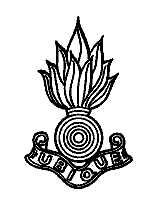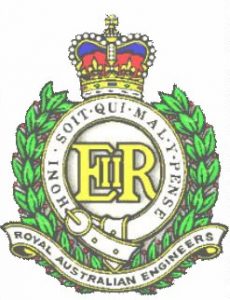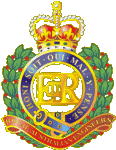What is a Sapper?
It is the correct title for an engineer private. It is also the generic term now given to all members of the Royal Australian Engineers. Many other armies of British descent have also adopted the term to describe military engineers. The word “sapper” was conferred by Queen Victoria as a distinction because of the gallant assault operation carried out by British Engineers in the Crimean War. The term originally comes from the term “to sap”. This was the art digging trenches, particularly during sieges to enable the infantry to get close enough to the fortified position to conduct an assault. The diggers were known as sappers.
Colonel-in-Chief
The Royal Australian Engineer Colonel-in-Chief is Her Majesty Elizabeth II.
Sovereign’s Banner
The Corps was presented with its Sovereign’s Banner on 1 July 1992. It is secured in the Dining Room of the RAE Officer’s Mess at the Engineer Centre. It is paraded on special events such as Freedom of the City parades and at special dining in nights at RAE Officer’s and Sergeant’s messes.
Corps Mottoes
The following mottoes are used within the Corps:
QUO FAS ET GLORIA DUCUNT
Where right and glory leads – (It appears on the Royal Coat of Arms)
FACIMUS ET FRANGIMUS
We make and we break – This is the original motto of the Australian Engineer adopted at Federation and appearing on the engineer hat badge up until 1947. It now only appears on the Corps Cipher.
UBIQUE
Everywhere – This motto was originally bestowed on Engineers and Gunners by King William IV in 1832 in recognition that both Sappers and Gunners were not entitled to carry Regimental Colours. This was because at most times they served as small detachments and never as a whole unit.
HONI SOIT QUI MAL Y PENSE
Evil to he who evil thinks – This motto which appears around the Garter on the Corps hat badge is also the motto of the Order of the Garter. It was bestowed on Australian Engineers in 1947 in recognition of service by the Corps during WWII.
Corps Badges
The Corps has two badges worn by all Sappers, they are the Hat Badge and the Flaming Grenade.

The Flaming Grenade
This badge or collar dog first appeared in 1824 on the coat tails of Royal Engineer Officer’s coats. No documented evidence can verify what was its real significance, but it has been speculated that it represents siege warfare when it first appeared. The Grenade is shared by both Engineers and Artillery, except that the number of flames differ, Sappers having nine and the Gunners having seven.

Hat Badge
It should be noted that the Royal Cipher monogram which is surrounded by the Garter belongs to Queen Elizabeth II. The monogram changes with each new monarch.
Regimental Music
The Corps marches to song and music of “Wings”.
Corps Songs
Songs sung within the Corps are “Hurrah for the CRE” and “The Shovel and Pick”.
Corps Poem
The adopted poem of the Corps is Rudyard Kipling’s “Sapper”.
Engineer’s Patron Saint
St Barbara is the patron saint of all engineers. She is a virgin martyr and a saint of the Christian Churches, her festival is on December 4th. Her father, a heathen, tortured and beheaded her himself on finding out she was a Christian. He himself was struck dead by lightning shortly after he carried out the punishment. For this reason St Barbara is regarded as the patron of thunderstorms and as the protectress of all those in danger of sudden death when using explosives, namely gunners, sappers and ordnance works.
Waterloo Dinner – an Engineer tradition
It is of interest that the RAE Annual Dinner the “Waterloo Dinner” was established on June 18th, 1915 at Gallipoli. Lieutenant Stan Watson, RAE signals officer, whilst serving on Gallipoli was directed to construct a pier at ANZAC Cove. On the completion of “Watson’s Pier”, it was decided to celebrate the completion of the task on 18th June 1915 which coincided with the 100th anniversary of the Battle of Waterloo. The date chosen was 18th June 1915, the 100th anniversary of the Battle of Waterloo. After the war, engineers continued to conduct a dinner for all officers on the Friday closest to the anniversary of the Battle of Waterloo. In recent years, engineers in Western Australia continue to conduct the Waterloo Dinner for sappers. As Lt Watson was a signal officer, it has always been traditional to invite a senior signals officer to the Dinner after the Corps of Signals was formed on Fed 14th, 1925. This tradition continues to this day.

